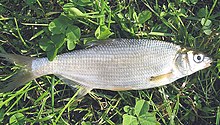Vimba vimba, called also the vimba bream,[2] vimba,[2] zanthe,[2] or zarte,[1] is a European fish species in the family Cyprinidae. It largely lives in the sea but makes an annual migration up-river each year to breed.
| Vimba vimba | |
|---|---|

| |
| Scientific classification | |
| Domain: | Eukaryota |
| Kingdom: | Animalia |
| Phylum: | Chordata |
| Class: | Actinopterygii |
| Order: | Cypriniformes |
| Family: | Cyprinidae |
| Subfamily: | Leuciscinae |
| Genus: | Vimba |
| Species: | V. vimba
|
| Binomial name | |
| Vimba vimba | |
| Synonyms | |
| |
Description edit
The vimba bream was at one time classified as a bream as it also has a long anal fin, but has now been placed in a different genus. Its body is not as deep as that of the bream. It also resembles the asp but its mouth is small and behind the snout whereas the asp has a large mouth with the lower jaw protruding. This species grows to about 25 to 45 centimetres (9.8 to 17.7 in) with a weight of up to 2 kilograms (4.4 lb). The scales are small and there are about sixty of them along the lateral line. This fish is a deep bluish-green on the dorsal surface and silvery along the flanks. The eyes are yellow and the pectoral and pelvic fins have reddish-yellow bases. The colouring becomes more vivid in the breeding season and males may have the operculum, base of the fins and the belly turn orange.[3]
Behaviour edit
Vimba breams move in small shoals along the sea coast, feeding on invertebrates which they pick from the seabed, and the eggs of other fish. They leave the sea in May or June, swimming upriver to spawn in fast-moving tributaries with stony or gravelly bases and little vegetation. The males prepares several areas of riverbed on which the females deposit batches of eggs.[3]
References edit
- ^ a b Freyhof, J.; Kottelat, M. (2008). "Vimba vimba". IUCN Red List of Threatened Species. 2008: e.T22979A9404802. doi:10.2305/IUCN.UK.2008.RLTS.T22979A9404802.en. Retrieved 15 November 2021.
- ^ a b c Froese, Rainer; Pauly, Daniel (eds.) (2006). "Vimba vimba" in FishBase. April 2006 version.
- ^ a b "Vimba: Vimba vimba". NatureGate. Retrieved 14 December 2013.
